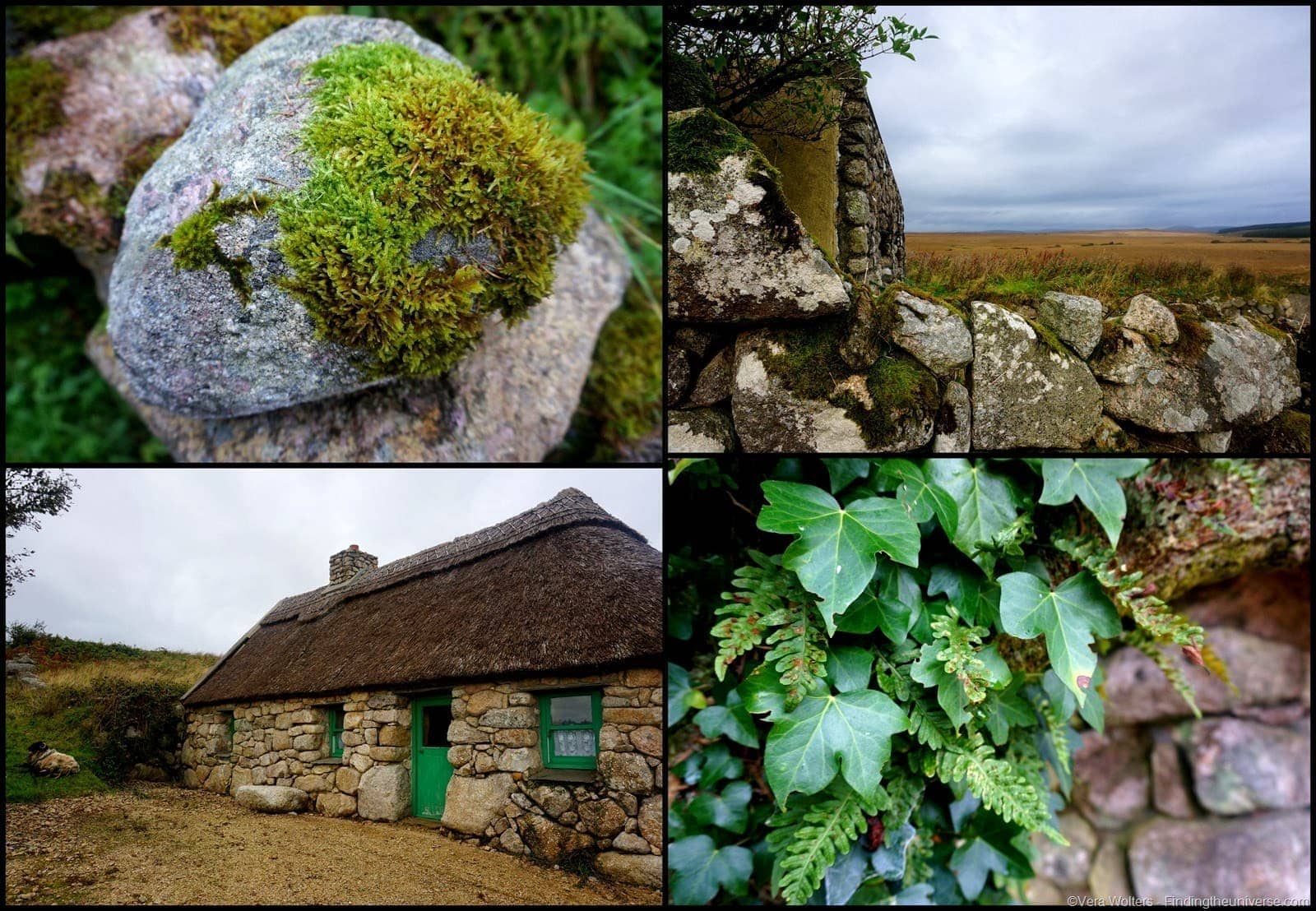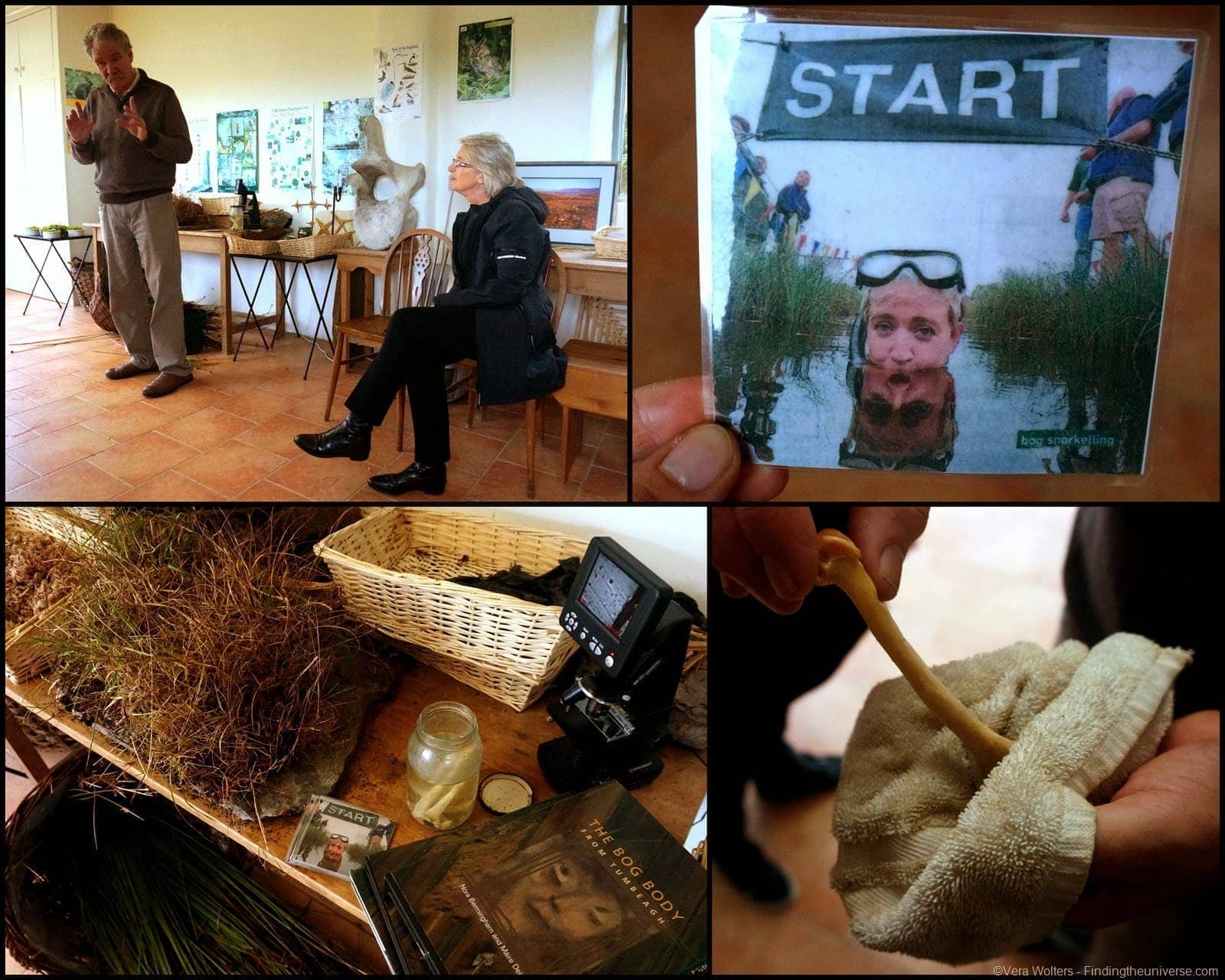Cnoc Suain. A name that rolls gently down your tongue… Just not my tongue, I’m afraid; no, sorry. We’re in a part of Ireland where the street signs are Irish only, and I might need a Guinness before I even dare to try to pronounce anything that is on them. But alas, there’s no Guinness, because we are on a bus and on our way to some historic cottages, known by the name of… Cnoc Suain. Which is Irish for “restful hill”. –Yes, yes, that was unexpected, I know. I thought it was a dish. Cnoc Suain. But maybe I’m just nibbly.
Anyway, Cnoc Suain is NOT a dish, and it’s in Western Ireland, more precise: in Connemara, just a half-hour ride from the city of Galway, home to those hookers. It’s not a shabby half an hour, either, noses pressed against the window, but when the bus stops and we walk a up the gateway to the cottages, we see a landscape that is the culmination of our trip here: simply rugged and beautiful.
A bit reluctantly we turn our backs on it to step through a bright red door into one of the pretty white houses with a thatch roof, where Dearbhaill Standún awaits us. She and her husband Charlie Troy own this homestead – and the 200 acres of land that belong to it. They have restored the buildings from the 17th century that had lain deserted for more than 50 years, and the result is impressive.
It’s here where you get a good chance to learn about and experience traditional Irish culture; be it the language, the history, the music, or the relation-ship of the people to the land and to nature. Although the setting might be historic, Dearbhaill bridges past and present easily. For her it’s not about remembering the old times; it’s about customs that are on the decline. Customs of great value that do in fact have a place in our modern world; practices that were part of life for hundreds of years for very good reasons.
Well, maybe not all of them, admittedly. For example, the reason why there are little windows in this cottage is because windows used to be taxed heavily. A policy that understandably did not go down so well with the people, who coined it “daylight robbery”, and sometimes even resorted to brick their windows up.
Indeed, there were a lot of things to keep in mind when you were planning to build a house. You needed building permission, but not from anyone, no. The ones who needed to be consulted in this matter were “the Good People” – fairies! So when you had found a good spot for your cottage, you would put four stones down on the ground to mark your chosen place, and then leave them overnight. Were they knocked down on the next morning, it meant that they were in the way of the Good People, and you should built your house somewhere else. Obviously you do not want to get in the way of fairies; I think we all know that much!
Dearbhaill also talks about the importance of music to the Irish. Instruments used to be hard to get. In the beginning of the last century, a lot of young teenage girls emigrated to America and would sent home parcels with money, clothes, food – and instruments.
Today you can easily buy musical instruments, but they don’t play the role they used to, back in the days when people visited each other all the time. Dearbhill also sings a song for us: it’s just her voice in the cottage, different tunes from what we’re used to but strangely intriguing and beautiful, even though we don’t understand any of the words, which are Gaelic.
The Irish language is in fact something that is very close to Dearbhill’s heart. There are three Irish speaking communities in Ireland today: Donegal, Connemara, and Kerry/Cork. Under British rule it was forbidden to speak or learn Irish, and during the Great Famine a significant part of the Irish population died or emigrated, dealing the language another blow.
Today a lot of effort is made to maintain the Irish language: every child learns it at school and has to pass an exam, too. Dearbhaill stresses that Irish needs to be spoken, and not taught like a dead language, which is how they started out with when they reintroduced it into the schools.
We learn about the secrets of the seemingly bleak landscape, which is in fact full of plants, many of which are only rediscovered today. They are not only good as food, but also as medicine, beauty product, cloth, dye… We are offered to try a traditional dessert, made of milk and …algae! Algae has always been on the Irish plate, but suffered from the reputation of being a food for poor people after the Great Famine. With the popularity of sushi the little versatile plant has found its way back into the light, and it’s hard to believe it had ever been shunned.
Dearbhaill even prepares a soda bread for us, but then Charlie takes over. He brings us to another room with many samples of greenery and other stuff, a microscope and posters on the wall. His mission: teaching us all about the bog. Probably most important: a bog is a preserve, “So don’t drop your dead bodies there!!” – good thing I learned that before falling for the temptation! A book about “Bog bodies” makes the round, and yes, point made – they don’t dissolve. Charlie passes a little animal bone around that he keeps in a jar with bog water, and sure enough, the bone feels and bends like it is made of rubber.
But the bog can do more: the peat from it can be cut out in pieces, dried and then burnt. This comes in handy in a country where there aren’t exactly dense forests everywhere, providing wood to heat your home. So even today people burn peat in their ovens, although it’s not necessarily hand-cut anymore, but taken out by a digger. Charlie is not a fan of this method, as the digger destroys the living layer of the bog, causing all sorts of problems.
To lighten things up, he recommends a session in the “bog spa” which will definitely give you a great permanent tan (due to the tannins) and is supposed to have anti-wrinkle properties. Somehow none of us runs out to immerge themselves in the bog… But there are people who do it, no kidding – hey, you can even go for bog snorkels! While we are still contemplating how you snorkel a bog, Dearbhaill asks us to follow her to another house, where Steve awaits us.
Steve is a musician, but the Irish kind, which means he’s a proper entertainer at the same time. He introduces and plays various instruments, tapping his feet and throwing in plenty of little jokes for good measure. He talks about pub music culture and sessions, about songs that have been passed on over 500 years, mouth music (also known as lilting) and finally urges Dearbhaill to join him with her violin for a little duet.
Seeing our heads bobbing along, he declares that of course in Ireland music comes with dancing, and wouldn’t we like to give it a try! Dearbhaill explains the choreography (“It’s like an American square dance!”) and we’re doing pretty well – at least that’s what we think before we realise that Steve has been playing extra-slow for us, because he’s getting a lot faster all of a sudden. Our limbs do not appreciate the tempo change and declare themselves too disoriented to go on without breaking a leg or at least embarrassing ourselves very much.
So we thank Steve and follow Dearbhaill and Charlie outside, where they take us on a last little walk to the remaining cottages which you can rent for a holiday. They talk about future projects, all which aim to integrate old knowledge into the present and show people how rich Gaelic culture is.
I think they’re doing pretty well – the hours we spent here flew by and I have the suspicion that what Dearbhaill and Charlie shared with us is just a fragment of their knowledge. I’m not surprised Cnoc Suain has won numerous awards, and I certainly wish them many more, as I think it’s a great thing they’ve got going on.
If this is the sort of thing that sounds interesting to you and you would like to visit, check out Cnoc Suains website, where you can find a contact form, and also learn more about Dearbhaill’s and Charlie’s background and their property in the Story section. Slán go fóill!
Our trip was part of the travel blogging conference TBEX in Ireland, and was made possible by Fáilte Ireland, Tourism Ireland and Cnoc Suain. Thanks a lot to everyone involved. The inability to pronounce Cnoc Suain properly to this very day remains entirely my own.






Leave a Reply